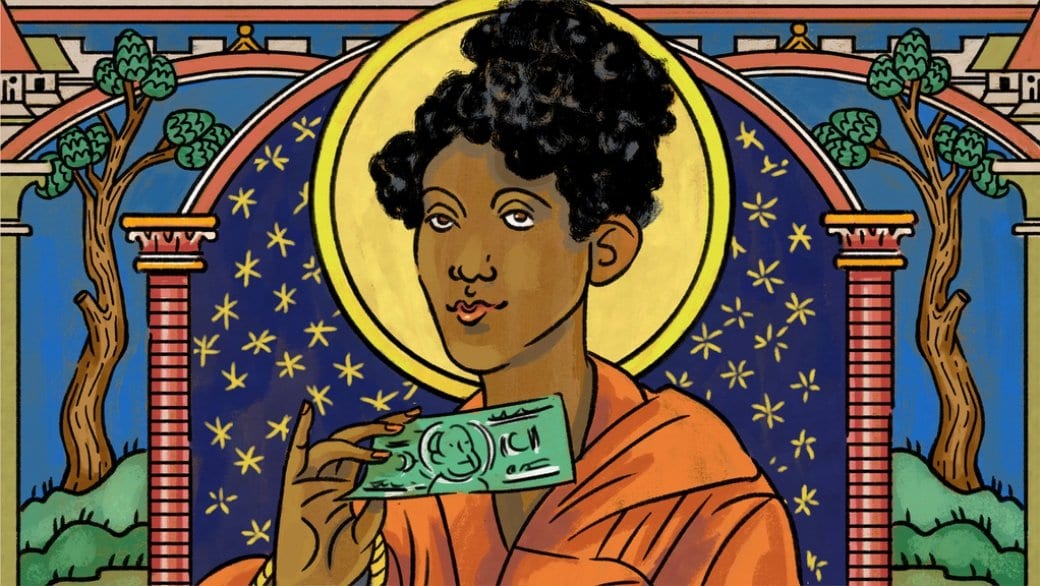“Scam today, before today scams you.”
Unless you’ve been living under a heterosexual rock over the past year, Joanne has probably scammed you. Joanne the Scammer is a lying, scamming, robbery-loving, frauding bitch who lives for drama. Joanne is a character, the social media creation of Daytona-based internet sensation Branden Miller, beginning her life in seconds-long videos where she describes her misadventures in crime. She also makes constant, tongue-in-cheek references to being caucasian, or her “caucasian lifestyle.” In an interview with The Fader, Miller, who is half-black and half-Puerto Rican and adopted by a white family as a child, explains how he spent his childhood thinking he was white.
Joanne’s racial incongruity is part of the titillating comedic tension. To me, there’s something empowering, intoxicating even, about her many contradictions, especially since the majority of targets for Joanne’s scams seem to be men.
Joanne the Scammer.
Super Deluxe/YouTube
Then again, white people have always been perversely obsessed with the spectacle of black criminality, especially today with the rise of black deaths being caught on camera. But we can draw a line between Joanne the Scammer and the case of Mary Jones in New York, who both reclaim the spectacle to make satire out of upper white society.
On June 11, 1836, a white mason worker named Robert Haslem visited the nexus of Lower Manhattan prostitution, Greene Street. Just off Broadway, later in the 19th century the tiny side-street from Canal to Bleecker would boast as many as 14 brothels. At the corner of Bleecker and Greene, Haslem approached a black woman dressed “elegantly and in perfect style” wearing white earrings and a gilt comb in her hair.
“Where are you going my pretty maid?” Haslem asked Jones before volunteering to go with her. The New York Herald described that at some point before concluding their business, Jones “lovingly threw her arms around him and strained him to her heart,” and “these delicate preludes having ended, they proceeded onwards until they arrived at an alley in Greene Street, which having entered . . . ” Followed by a suggestive string of asterisks.
As he walked away from the liaison, Haslem realized his wallet with $99 (more than $2,000 today) had been switched with a stranger’s wallet, empty save a bank receipt for $200. He found the owner of this wallet, who denied ownership at first before admitting that he’d also engaged Mary Jones the same night, but feared exposing his tryst by reporting the theft to the authorities. Together, they went to the police where a Constable Bowyer took up the case.
That evening, nearing midnight, Bowyer passed a woman on the street who he believed was Jones. “Where are you going at this time of night?” he demanded to know.
“I am going home, will you go too?” and she led him to her apartment on Greene Street. He declined to go in, but instead went with her to an alley where she set about her business. After she “proceeded to be very affectionate,” Bowyer arrested her. A tussle ensued where Jones attempted to throw away two wallets from her “bosom,” one of which was Haslem’s. On the way to jail, she attempted to toss away another — I love to imagine wallets falling out of her décolletage at every turn. Bowyer searched her apartment, found a number of other wallets, searched Jones and “for the first time discovered that he was a man.”

Mary Jones appeared in court on June 16, “neatly dressed in female attire,” according to the New York Sun. The New York World corroborated that Jones was dressed, “elegantly, and in perfect style. Her or his dingy ears were decked with a pair of snow-white earrings, his head was ornamented with a wig of beautiful curly locks, and on it was a gilt comb, which was half hid amid the luxuriant crop of wool,” her waist “squeezed into a size that would have put to blush the veriest dandy in the city, and his or her toute [sic] ensemble was engaging in the extreme.”
During the proceedings, the “grave Recorder laughed till he cried,” and a spectator, “seated behind the prisoner’s box, snatched the flowing wig from the head of the prisoner,” which “excited a tremendous roar of laughter throughout the room.” Polite society indeed.
The little biographical information we have on Mary Jones comes from a court affidavit: “I will be thirty three Years of age on the 12th day of December next, was born in this City, and get a living by Cooking, Waiting [and] live No. 108 [Greene] St.” She offered the fact that she’d “been in the State service,” military duty, as grounds for leniency. Asked what her “right name” was, Jones replied, “Peter Sewally. I am a man,” though the illiterate prisoner used neither her birth name or chosen one on a statement, instead signing “X.”

The New York Sun helpfully explains that Bowyer discovered how she had conducted her business with so many men. Jones had outfitted herself with a prosthetic — a piece of cow leather, or meat? — pierced to imitate female genitalia, held up by a girdle. This description was written in Latin, apparently so upper class (white) men could have their curiosities satiated, while women and uneducated people were left wondering. This revelation earned Jones the unpalatable sobriquet, “Beefsteak Pete.”
The Sun described that, during the day, Sewally “generally promenades the street, dressed in a dashing suit of male apparel,” and how at night she “prowls” the disreputable parts of town, luring men into “dens of prostitution” to pickpocket them, protected by the humiliation they’d face if they reported the crime.
In other words, she scammed their hypocritical asses.
Jones pleaded not guilty, explaining that she’d never seen Haslem or any of the wallets, but after consulting for a few minutes, the jury returned with a verdict of grand larceny. About a week later, a popular tabloid lithographer reported that “The Man-Monster, Peter Sewally, alias Mary Jones . . . sentenced 18th June 1836 to 5 years imprisonment at hard labor at Sing Sing for Grand Larceny.”
Oddly, the “Man-Monster” was depicted as rather pretty, in a voluminous white dress, snow-white earrings, gold-gilded comb and all. The spectacle complete, the prowling, “dingy” black “Man-Monster” defeated by the prim, proper, white justice system, Mary Jones disappeared, never to be heard of again.

 Credit: @joanneprada/Twitter
Credit: @joanneprada/Twitter
Some scholars and historians suggest that Jones was made to appear in women’s clothing by the police and court, not at all surprising given her cruel treatment on the stand. Her guilt seemed predetermined, they were clearly there for the spectacle. However, when asked why she dressed in women’s clothing, Jones replied:
“I have been in the practice of waiting upon Girls of ill fame and made up their Beds and received the Company at the door and received the money for Rooms [and] they induced me to dress in Women’s Clothes, saying I looked so much better in them and I have always attended parties among the people of my own Colour dressed in this way — and in New Orleans I always dressed in this way.”
Among sex workers and black people, Jones had no immediate problems. She seemed to even get away with her “practical amalgamation” — a term used by the Herald, referring to sex between white and black people — via prosthetic. It wasn’t cross-dressing or sex work that led to her arrest, but pickpocketing white men.
Keep in mind that New York had only completed the abolishment of slavery in 1827, less than a decade previous. Dehumanizing Mary Jones was easy because she was someone that white society feared: black, gender deviant, a sex worker, a criminal, and, probably worst of all, free. She served as a titillating, anti-abolitionist warning against the “social chaos” of free black people in white society, writes LGBT studies academic Tavia Amolo Ochieng’ Nyongó.
I used feminine pronouns for Mary Jones because her story surrounds her feminine persona. She may have been what we consider trans-identified, or non-binary, since she lived comfortably as a man or woman. Now almost 200 years on we have another gender deviant, beautiful, spectacle of a criminal personality in Joanne the Scammer.
The justice in the end is that Mary Jones’ spectacle was created by and for white audiences at the expense of a poor, black person, while Joanne was created for a laugh by a black queer man for his communities, one could argue, at the expense of proper white society.
Maybe the only difference between their popularity, aside from Mary Jones’ true crimes and ultimately tragic story, is a couple of centuries and the internet. Joanne’s statement, “So many male victims, so little time,” could just have easily have been Mary Jones’ MO. Iconic.
History Boys appears on Daily Xtra on the first and third Tuesday of every month. You can also follow them on Facebook.


 Why you can trust Xtra
Why you can trust Xtra


